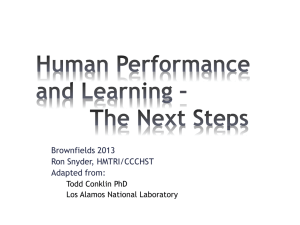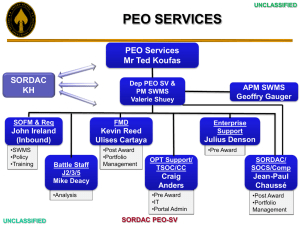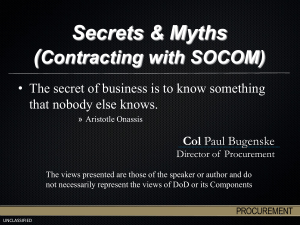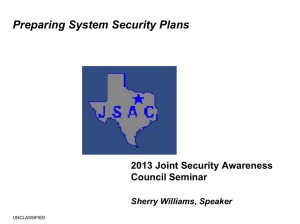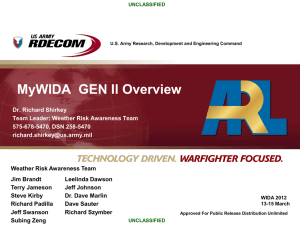PPT of Presentation - People.fas.harvard.edu
advertisement
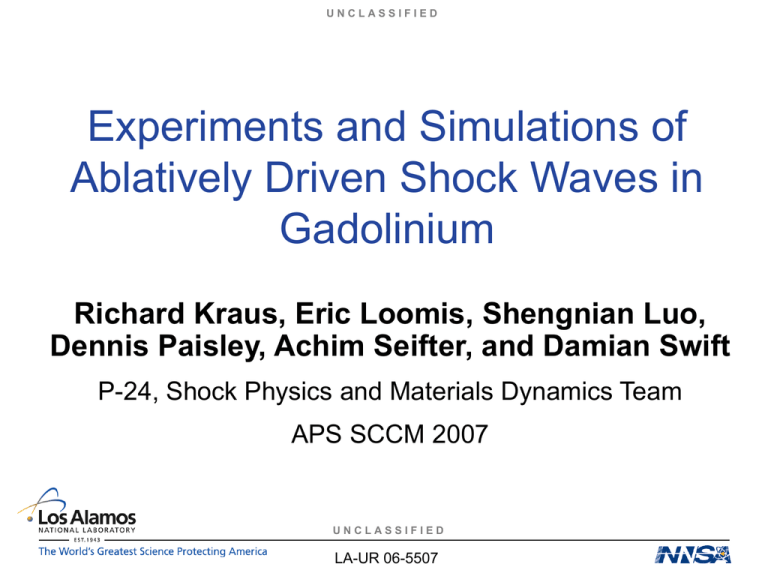
UNCLASSIFIED Experiments and Simulations of Ablatively Driven Shock Waves in Gadolinium Richard Kraus, Eric Loomis, Shengnian Luo, Dennis Paisley, Achim Seifter, and Damian Swift P-24, Shock Physics and Materials Dynamics Team APS SCCM 2007 UNCLASSIFIED LA-UR 06-5507 UNCLASSIFIED Abstract Lanthanides are fascinating metals to study because they exhibit physical properties that vary with 4f occupancy. Another important reason to study lanthanides is that they may provide basic level information about actinides while being safer and easier to handle. Specifically Gadolinium is interesting because there are multiple structural phase transitions accessible below 100 GPa. Experiments were performed on Gadolinium metal in which shock waves were driven in Gadolinium foils through direct laser ablation. The velocity at the opposite surface of the drive beam was measured with line-imaging laser Doppler velocimetry of the Velocity Interferometer System for Any Reflector (VISAR) type. Simulations of the experiment were done using a radiation hydrodynamic model which takes the measured irradiance history of the laser and predicts the pressure history at the ablation surface; this pressure history is then used as a time-dependant boundary condition for a continuum mechanics simulation. From this we obtain a simulated surface velocity profile, which we then compare with the velocity profile obtained by the line VISAR diagnostic technique to validate the simulations. With this experimental series we achieved shock pressures under ten gigapascals; specific experimental and simulated results to be presented. UNCLASSIFIED UNCLASSIFIED Shocks Driven by Laser Ablation 2.4 ns pulse length at 527 nm. High irradiance causes the back surface of the sample to ionize. Plasma pressure causes sudden increase in pressure and supports shock wave through sample. UNCLASSIFIED UNCLASSIFIED Trident Laser Facility and Experimental Setup Facility used for shock studies Variable pulse length (ms to ps) and pulse shape. Energies up to 500 Joules 1054 nm, 527 nm, 351 nm, andU N C L A S S I F I E D 264 nm UNCLASSIFIED Velocimetry VISAR System for this Experiment Etalon chosen so as to obtain an 800 m/s fringe constant (i.e. one full fringe shift means an 800 m/s surface velocity) Position Line imaging, so as to obtain the velocity history of the surface along a 1 mm line. Time Gd disc 1 mm UNCLASSIFIED 6 mm UNCLASSIFIED 4 Gadolinium Hugoniot 4f electron metal 3 bcc multiple phase changes below 100 hex(9) 2 GPa Oxidizes relatively slowly 1 Safe to handle Polycrystalline, 25 mm thick foils from Goodfellows. Liquid hcp 500 1000 T(K) 1500 Low pressure phase Gadolinium Hugoniot High pressure phase us ci si u p From S.P. Marsh, 1980 Low Pressure Phase: C0= 2.21 km/s , S0= 0.92 41 GPa High Pressure Phase: C1= 1.77 km/s, S1= 1.29 UNCLASSIFIED 2000 UNCLASSIFIED Shot 18809 and 18813 These 4 shots were taken with a 2 mm Lithium Fluoride window attached to the VISAR side of the 25 mm Gadolinium sample. A window is used to prevent pressure release into the sample. 18809, Laser Energy= 16 J 18813, Laser Energy= 26 J Peak Pressure= 4.1 GPa Peak Pressure= 4.9 GPa UNCLASSIFIED UNCLASSIFIED Shot 18814 and 18817 18814, Laser Energy= 44 J 18817, Laser Energy= 75 J Peak Pressure= 6.0 GPa Peak Pressure= 5.4 GPa UNCLASSIFIED UNCLASSIFIED Simulating the Shock Radiation Hydrodynamics in 1D (HYADES program) Solves continuum mechanical equations in numerical form governing conservation of mass, momentum, and energy explicitly for each mesh Includes Thomas Fermi ionization model to simulate laser induced ionization. Continuum Mechanics in 1D (LagC program) Solves same continuum mechanical equations as HYADES Can include strength model such as Steinberg-Guinan These simulations did not include strength model. UNCLASSIFIED UNCLASSIFIED Simulating the Shock Pressure (1 mm) Laser irradiance used as input for HYADES Pressure @ 1 mm from ablated surface is used as a boundary condition for LagC UNCLASSIFIED UNCLASSIFIED Simulating 18809 and 18813 Experimental parameters were determined and applied as accurately as possible to the simulations for each shot. 18809, Laser Energy= 16 J Shot 18809 18813, Laser Energy= 26 J Shot 18813 UNCLASSIFIED UNCLASSIFIED Simulating 18814 and 18817 18814, Laser Energy= 44 J Shot 18814 18817, Laser Energy= 75 J Shot 18817 UNCLASSIFIED UNCLASSIFIED Experiment vs. Simulations Experiment and Simulations agree to within the error bars on 3 out of 4 shots. Where it does not agree I believe the VISAR trace to lose signal before the surface is done accelerating. UNCLASSIFIED UNCLASSIFIED Problems and Difficulties The surface of the Gadolinium sample was not polished initially. The reflectivity of the Gadolinium surface decreases significantly when the shock front reaches it; making it difficult to trace the fringes a few ns after shock breakout. The drive energy used in these shots was not enough to reach more than one phase change boundary. UNCLASSIFIED 20 ns UNCLASSIFIED Solutions and Future Plans Samples will be polished to obtain a strong specular reflection. Or, could coat the back surface of the LiF window with Aluminum Implement additional diagnostics, such as ellipsometry, to detect phase changes. Use more robust velocimetry system to obtain better VISAR fringes. Example of better VISAR trace obtained recently (Data not yet analzed) UNCLASSIFIED UNCLASSIFIED Acknowledgements I would like to express my thanks to the following individuals. Damian Swift Achim Seifter Shengnian Luo Dennis Paisley Eric Loomis Trident Laser Facility Staff UNCLASSIFIED
